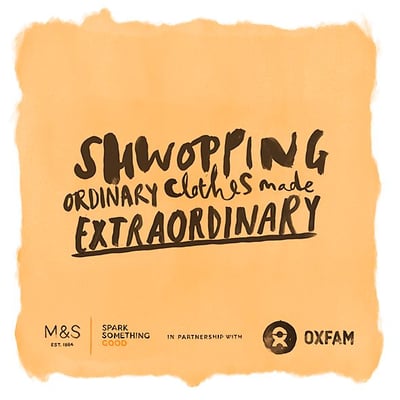Sustainability is a hot topic at the moment. The sourcing of raw materials, production and transportation of products, from farm to shelf, is vitally important. However, another important subject to touch upon is the level and rate of our consumption of these products; is it sustainable in itself?
ONLINE SHOPPING
In 2017, retail sales in the UK were worth £395 billion - for every pound spent, 12 pence was spent in clothing shops alone. With the rise in technology and a fast fashion culture, the convenience and lower price of internet shopping means that it now accounts for 18% of all retail shopping. According to a survey commissioned by Royal Mail, the average online clothes shopper spends £40 a month, with 55% of female shoppers purchasing clothes online, compared to 33% of male shoppers.
Social pressures from the media are causing consumers to buy more than they ever did before and much more than they need. A study by Greenpeace found that consumers are over-consuming to feel excitement, satisfaction and confidence in front of others but also to release stress, kill time and relieve boredom. Women are said to have adopted a ‘wear it once culture’; a survey of 2,000 women found some clothing is only worn seven times before being regarded as old and pushed to the back of the wardrobe, or even sent to landfill, with 33% saying that clothing worn only three times could be considered old.
SEASONAL SHOPPING
 Christmas is looming, gifts are being bought, wrapped up and put under the tree, spirits are heightened and so is the level of consumption. We are consuming more and more each year over the Christmas period (mid-November to December 2017) - the UK spent £78.69 billion, a 1.4% increase compared to 2016. In fact, textiles, clothing and footwear stores had the highest year on year growth over December 2017 with a whopping 20.4% increase in sales.
Christmas is looming, gifts are being bought, wrapped up and put under the tree, spirits are heightened and so is the level of consumption. We are consuming more and more each year over the Christmas period (mid-November to December 2017) - the UK spent £78.69 billion, a 1.4% increase compared to 2016. In fact, textiles, clothing and footwear stores had the highest year on year growth over December 2017 with a whopping 20.4% increase in sales.
But has the meaning behind giving these gifts become lost? “Across the country people are growling at the enforced obligation to waste money on tat they can’t afford for people who won't use it” – this doesn’t make sense for already pressured household budgets and it certainly isn’t good for the environment.
Whether it's a naff knitted jumper from Aunty Beryl or a novelty naughty nurse outfit from your workmates, unused gifts are sent all the time to fulfil seasonal obligations. It's money spent on unneeded, unwanted and unused goods. That's bad for our finances, doesn't help the environment and just clogs up landfills.
Martin Lewis
Founder of Money Saving Expert
IMPACT ON THE ENVIRONMENT AND BUSINESSES
Experts warn that our increasing levels of fashion consumption are a danger to the environment, the planet cannot cope.
Globally, we’re producing over 100 billion new garments from new fibres every single year, and the planet cannot sustain that.
Lucy Seigle
Environmental Journalist
The raw materials that these products are derived from, the manufacturing and transportation processes can significantly impact the environment and are contributing towards global warming.
Consumers may not be aware of the impact that their clothing is having on the environment, and sometimes neither does the brand or retailer if they don’t have supply chain transparency, but this doesn’t mean they do not care. Even without this level of insight brands and retailers could still be at risk of being held accountable if poor supplier behaviours are discovered.
Continuing with current consumption patterns in Europe is not an option. As both population and purchasing power swell worldwide, resources will be ever more overused and constrained. Europe must take the lead in exploring a new model of consumption which does not compromise the needs of others or of future generations, nor damage the environment.
Jacqueline McGlade
EEA Executive Director
Stacey Dooley’s documentary ‘Fashions Dirty Secrets’ highlighted that cotton totals 43% of all clothing. It takes approximately 20,000 litres of water to produce just one kilogram of cotton - this is enough to manufacture one t-shirt and one pair of jeans. The impact of this dramatically changes our world’s landscapes. Kazakhstan was once the home of the Aral Sea, full of fish and wildlife, it is now left as a desert as a direct result of the cotton production. Now only 25 percent of its original size the Aral Sea holds just 10 percent of its original volume of water, devastating to the local communities, the wildlife, the landscape and the environment surrounding it.
SUSTAINABLE CONSUMPTION
Consumers can make more informed purchases, by buying better quality, well sourced, long-lasting garments, and wearing them more; whilst supporting the brands and retailers that focus their efforts on causing minimal damage to the environment and are protecting the people that make their products.
 Brands and retailers can work with consumers using initiatives such as John Lewis’ buyback scheme. This allows consumers to sell their unwanted items back to the retailer, where the item is repaired and resold or recycled. In return the consumer receives a gift card to spend back at John Lewis. Similarly, M&S have a schwopping scheme that allows consumers to take unwanted clothing into an M&S store, drop it into a “Schwop Drop” box which then gets donated directly to Oxfam, all adding to the reduction, reuse and recycling to avoid landfill.
Brands and retailers can work with consumers using initiatives such as John Lewis’ buyback scheme. This allows consumers to sell their unwanted items back to the retailer, where the item is repaired and resold or recycled. In return the consumer receives a gift card to spend back at John Lewis. Similarly, M&S have a schwopping scheme that allows consumers to take unwanted clothing into an M&S store, drop it into a “Schwop Drop” box which then gets donated directly to Oxfam, all adding to the reduction, reuse and recycling to avoid landfill.
Fast fashion does not need to be unsustainable. With the right approach to your supply chain, working with accredited suppliers and adopting technology, brands and retailers can track their interactions and ensure their products have come from a sustainable source, as well as confirming the factories that they are auditing are in fact the ones being used. With this level of transparency, brands and retailers can also mitigate risk, avoid supply chain disruptions and still provide the speed to market that consumers expect.
Originally Published 27/11/2018


